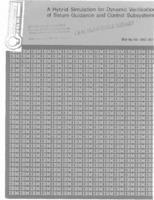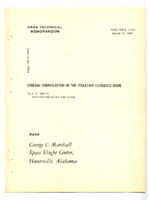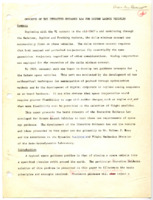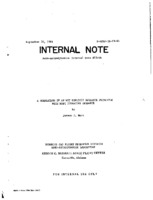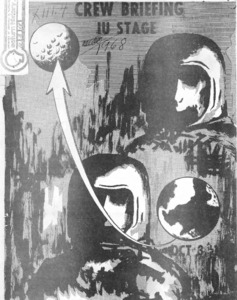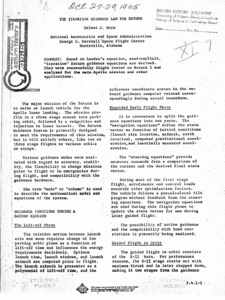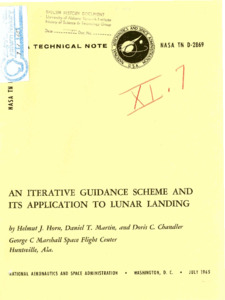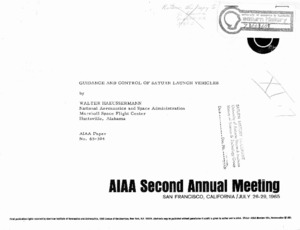
Browse Items (11 total)
Sort by:
-
"A Hybrid Simulation for Dynamic Verification of Saturn Guidance and Control Subsystems."
This paper presents a discussion of a hybrid simulation used to dynamically verify the Saturn Guidance and Control subsystems. First, the Saturn vehicle is briefly described to provide background information. The Instrument Unit (IU) is considered in more detail to give a proper setting for the Guidance and Flight Control (G and FC) discussion that follows. After a brief description of the actual G and FC System operation, simulation models of the G and FC components are considered in detail. This is followed by a discussion of the model assignment to a particular computer (digital or analog) and justification for making that assignment. Finally, results of the AS-204/LM1 hybrid simulation studies are briefly considered with mention of the actual flight data. -
"General Formulation of the Iterative Guidance Mode."
From the abstract: "This report discusses the iterative guidance mode and its application to three-dimensional upper stage vacuum flight. It is an inertial or closed system mode in that the only inputs required after liftoff are available from the onboard navigation system. That is, the iterative scheme computes steering commands as a function of the state and of the vehicle - velocity, position, longitudinal acceleration, and gravitational acceleration - and the desired cutoff conditions. The guidance commands are updated each guidance cycle, using the updated state of the vehicle. The iterative guidance scheme is a path adaptive guidance scheme in that it will retain its optimization properties under all expected types and magnitudes of vehicle perturbations without any loss in accuracy at liftoff." -
Draft of "Concepts of the Iterative Guidance Law for Saturn Launch Vehicles."
The summary notes, "In 1960, research work was begun to develop new guidance concepts for the Saturn space vehicles. [...] This paper presents the basics of the Iterative Guidance Law developed for Saturn launch vehicles to meet these new requirements of space age guidance. The development of the Iterative Guidance Law and the results and ideas presented in this paper are due primarily to Mr. Helmut J. Horn and his associates in the Dynamics Analysis and Flight Mechanics Division of the Aero-Astrodynamics Laboratory." Marked "Research Review, OK" in the upper right corner of the first page. The document includes corrections and additions to the text in red pencil. -
"A Comparison of an MIT Explicit Guidance Principle with MSFC Iterative Guidance."
From the summary: "Both [guidance] schemes steer toward a specified end point. The MIT scheme uses thrust to cancel out the effective gravity, a nonlinear term, which may be inefficient in certain cases. The MSFC scheme is more closely connected with calculus of variations and optimization theory in a reasonable degree of approximation." -
"Crew Briefing : Instrument Unit Stage Presentation".
Document outlining different slides of a presentation containing numerous organizational charts, diagrams and bullet-list points. -
"The Iterative Guidance Law for Saturn."
Summary: "Based on Lawden's equation, semi-explicit,'iterative' Saturn guidance equations are derived, many were successfully flight tested on Saturn I and analyzed for the main Apollo mission and other applications applications." -
"An Iterative Guidance Scheme and Its Application to Lunar Landing."
A guidance scheme for vehicle flight from lunar orbit to a prescribed point on a spherical, non-rotating moon is presented. The equations of motion have been simplified only to perm it a closed solution for the thrust magnitude and thrust direction. The trajectory computations them selves are made under more realistic and accurate assumptions and are not included. -
"Guidance and Control of Saturn Launch Vehicles."
The navigation, guidance, and control modes and problems of the Saturn launch vehicles are given as the requirements for the guidance and control methods. Two path adaptive guidance modes, featuring flight path optimization, in the form of a polynomial mode and an iterative mode are given in their computation form and compared with respect to mission flexibility, implementation requirements, and performance. Attitude control during the propelled flight phases requires consideration of various bending and sloshing modes; stability of the control system is obtained by phase stabilization of the low frequencies and by attenuation of the higher frequencies. Typical shaping networks and their transfer functions are given. The attitude control system during coasting periods is briefly described. The functional behavior and characteristic data of the main guidance and control hardware such as the inertial sensors, stabilized platform, digital computer, data adapter, control computer, and actuation system are described. Reliability requirements are emphasized. The principle of redundancy is extensively used to obtain highest reliability for long operating times. Data and results from recent Saturn I flights summarize the performance of the guidance schemes. -
"Fact Sheet : IBM Computer Will Direct Saturn Orbital Test Flight."
Press release regarding a IBM digital computer directing a Saturn 1B orbital mission. -
"Crew Briefing : Instrument Unit Stage Presentation".
Document outlining different slides of a presentation containing numerous organizational charts, diagrams and bullet-list points.
